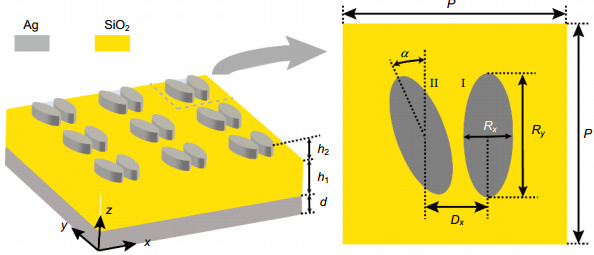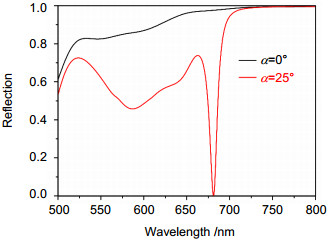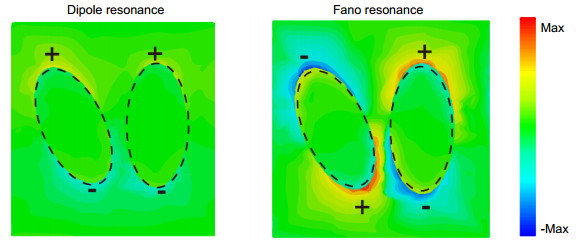-
摘要:
基于表面等离子体共振的金属纳米结构传感器具有测量精度高、易集成的特点,已广泛应用于生物、化学、材料、光子学和生命科学等诸多领域。然而由于表面等离子体共振在可见光波段具有较大的辐射损耗,导致等离子体共振传感器谐振峰较宽,极大地限制了传感器的性能。本文采用不对称双椭圆柱结构在等离子体共振传感器中引入不对称性,产生Fano共振以实现窄带光谱特性。通过优化结构参数,在681 nm波长处,得到了半高全宽(FWHM)仅为10.8 nm的谐振谷。该传感器在环境折射率1.0~1.1的变化范围内,折射率灵敏度可以达到299 nm/RIU,品质因数可以达到27.8。该传感器在高折射率灵敏度传感应用方面有着巨大的潜力。
 Abstract:
Abstract:Plasmonic sensor based on metallic nanostructures is a promising platform for applications, such as biology, chemistry, materialogy, photonics and bioscience due to their attractive properties. However, the sensitivity of plasmonic sensors is usually limited by broad-spectral features due to large radiative loss of metallic nanostructures in visible region. In this paper, we introduce structural asymmetry to generate the Fano resonance in the metallic nanostructure composed of asymmetric ellipsoidal pair. The distinct Fano-like resonance around wavelength of 681 nm possesses sharp peak as narrow as 10.8 nm. And the Fano mode exhibits high refractive index sensitivity as large as 299 nm/RIU. Due to the excitation of sharp spectral features, high figure of merit of 27.8 at the Fano resonance is obtained in a wide refractive index range of 1.0~1.1. This device is promising for the applications of high sensitivity microchip sensor.
-
Key words:
- plasmon resonance /
- sensor /
- Fano resonance
-

Abstract: Plasmonic sensor based on metallic nanostructures is a promising platform for applications, such as biology, chemistry, materiality and photonics due to their attractive properties. In particular, the local electromagnetic field enhancement in metal nanostructures is highly correlated to the surrounding environment, providing a new way for the realization of high sensitive biosensors. However, the sensitivity of plasmonic sensors is usually limited by broad spectral features due to large radiative loss of metallic nanostructures in visible region. As a result of the interference between super-radiation and sub-radiation patterns, the radiation loss of the Fano resonance system can be greatly reduced or even completely inhibited. Such characteristic promises the Fano resonance a series of excellent electromagnetic properties such as narrow spectral linewidth, strong electromagnetic field enhancement and high refractive index sensitivity. In this paper, we present a structure of three layers consisting of an ellipsoidal silver pair separated from the silver reflector by a layer of silica. Moreover, we introduce structural asymmetry to generate the Fano resonance by rotating one of the elliptical silver cylinders. The Fano resonance in this structure is raised by the interference of dipole resonance aroused by the incident light and quadrupole mode aroused by the asymmetry of the ellipsoidal pair. Here, the dipole mode and quadrupole mode represent the super-radiation and sub-radiation pattern, respectively. The corresponding results are based on the finite element method (FEM) with solver CST Microwave Studio. Electromagnetic wave incidents normally to the surface from the positive side of the z axis and polarization of the incident light are along the x axis. Calculated results show that the distinct Fano-like line shape with sharp peak as narrow as 10.8 nm (FWHM) appears around a wavelength of 681 nm, and also at the same wavelength, two anti-phase currents appears along two asymmetric elliptical cylinders which indicate the arose of Fano resonance. We should point out that when the structure is symmetric, therea€?s on Fano resonance, and also with the increase of the asymmetry degree, the intensity of Fano resonance increases. According to formula for the refractive index sensitivity, the Fano mode exhibits refractive index sensitivity as large as 299 nm/RIU which is the basis of many applications. Moreover, due to the excitation of sharp spectral features, high figure of merit of 27.8 at the Fano resonance is obtained in a wide refractive index range of 1.0~1.1. The promising properties of this device would make it an effective high sensitivity microchip sensor.
-

-
-
[1] Polman A. Applied physics: plasmonics applied[J]. Science, 2008, 322(5903): 868-869. doi: 10.1126/science.1163959
[2] Schuller J A, Barnard E S, Cai Wenshan, et al. Plasmonics for extreme light concentration and manipulation[J]. Nature Materials, 2010, 9(3): 193-204. http://cn.bing.com/academic/profile?id=adc0adec83af305124b55bcc3151ee5b&encoded=0&v=paper_preview&mkt=zh-cn
[3] Guo Yinghui, Yan Lianshan, Pan Wei, et al. A plasmonic splitter based on slot cavity[J]. Optics Express, 2011, 19(15): 13831-13838. doi: 10.1364/OE.19.013831
[4] Atwater H A, Polman A. Plasmonics for improved photovoltaic devices[J]. Nature Materials, 2010, 9(10): 205-213. https://www.researchgate.net/publication/46414224_Plasmonics_for_Improved_Photovoltaic_Devices
[5] Pu Mingbo, Hu Chenggang, Wang Min, et al. Design principles for infrared wide-angle perfect absorber based on plasmonic structure[J]. Optics Express, 2011, 19(18): 17413-17420. doi: 10.1364/OE.19.017413
[6] Stewart M E, Anderton C R, Thompson L B, et al. Nanostructured plasmonic sensors[J]. Chemical Reviews, 2008, 108: 494- 521. doi: 10.1021/cr068126n
[7] Kabashin A V, Evans P, Pastkovsky S, et al. Plasmonic nanorod metamaterials for biosensing[J]. Nature Materials, 2009, 8(11): 867-871. doi: 10.1038/nmat2546
[8] Larsson E M, Alegret J, K ll M, et al. Sensing characteristics of NIR localized surface plasmon resonances in gold nanorings for application as ultrasensitive biosensors[J]. Nano Letters, 2007, 7(5): 1256-1263. doi: 10.1021/nl0701612
[9] Rodriguez S R K, Abass A, Maes B, et al. Coupling bright and dark plasmonic lattice resonances[J]. Physical Review X, 2011, 1(2): 021019. doi: 10.1103/PhysRevX.1.021019
[10] Moritake Y, Kanamori Y, Hane K. Experimental demonstration of sharp Fano resonance in optical metamaterials composed of asymmetric double bars[J]. Optics Letters, 2014, 39(13): 4057- 4060. doi: 10.1364/OL.39.004057
[11] Cetin A E, Altug H. Fano resonant ring/disk plasmonic nanocavities on conducting substrates for advanced biosensing[J]. ACS Nano, 2012, 6(11): 9989-9995. doi: 10.1021/nn303643w
[12] Song Maowen, Yu Honglin, Wang Changtao, et al. Sharp Fano resonance induced by a single layer of nanorods with perturbed periodicity[J]. Optics Express, 2015, 23(3): 2895-2903. doi: 10.1364/OE.23.002895
[13] Pu Mingbo, Hu Chenggang, Huang Cheng, et al. Investigation of Fano resonance in planar metamaterial with perturbed periodicity[J]. Optics Express, 2013, 21(1): 992-1001. doi: 10.1364/OE.21.000992
[14] Fedotov V A, Rose M, Prosvirnin S L, et al. Sharp trapped-mode resonances in planar metamaterials with a broken structural symmetry[J]. Physical Review Letters, 2007, 99(14): 147401. doi: 10.1103/PhysRevLett.99.147401
[15] Merbold H, Bitzer A, Feurer T. Near-field investigation of induced transparency in similarly oriented double split-ring resonators[J]. Optics Letters, 2011, 36(9): 1683-1685. doi: 10.1364/OL.36.001683
[16] Liu Shaoding, Yang Zhi, Liu Ruiping, et al. Plasmonic-induced optical transparency in the near-infrared and visible range with double split nanoring cavity[J]. Optics Express, 2011, 19(16): 15363-15370. doi: 10.1364/OE.19.015363
[17] Mukherjee S, Sobhani H, Lassiter J B, et al. Fanoshells: nanoparticles with built-in Fano resonances[J]. Nano Letters, 2010, 10(7): 2694-2701. doi: 10.1021/nl1016392
[18] Hao Feng, Sonnefraud Y, Van Dorpe P, et al. Symmetry breaking in plasmonic nanocavities: subradiant LSPR sensing and a tunable Fano resonance[J]. Nano Letters, 2008, 8(11): 3983-3988. doi: 10.1021/nl802509r
[19] Liang Yuzhang, Peng Wei, Li Lixia, et al. Tunable plasmonic resonances based on elliptical annular aperture arrays on conducting substrates for advanced biosensing[J]. Optics Letters, 2015, 40(16): 3909-3912. doi: 10.1364/OL.40.003909
[20] Fu Yuan Hsing, Zhang Jingbo, Yu Yefeng, et al. Generating and manipulating higher order Fano resonances in dual-disk ring plasmonic nanostructures[J]. ACS Nano, 2012, 6(6): 5130-5137. doi: 10.1021/nn3007898
[21] Chang Weishun, Lassiter J B, Swanglap P, et al. A plasmonic fano switch[J]. Nano Letters, 2012, 12(9): 4977-4982. doi: 10.1021/nl302610v
[22] Ye Jian, Wen Fangfang, Sobhani H, et al. Plasmonic nanoclusters: near field properties of the Fano resonance interrogated with SERS[J]. Nano Letters, 2012, 12(3): 1660-1667. doi: 10.1021/nl3000453
[23] Bozhevolnyi S I, Jung J. Scaling for gap plasmon based waveguides[J]. Optics Express, 2008, 16(4): 2676-2684. doi: 10.1364/OE.16.002676
[24] Malitson I H. Interspecimen comparison of the refractive index of fused silica[J]. Journal of the Optical Society of America, 1965, 55(10): 1205-1209. doi: 10.1364/JOSA.55.001205
[25] Fedotov V A, Rose M, Prosvimin S L, et al. Sharp trapped-mode resonances in planar metamaterials with a broken structural symmetry [J]. Physical Review Letters, 2007, 99(14):147401. doi: 10.1103/PhysRevLett.99.147401
[26] Luk'yanchuk B, Zheludev N I, Maier S A, et al. The Fano resonance in plasmonic nanostructures and metamaterials[J]. Nature materials, 2010, 9: 707-715. doi: 10.1038/nmat2810
-


 E-mail Alert
E-mail Alert RSS
RSS

 下载:
下载:







